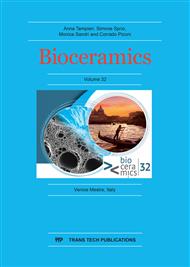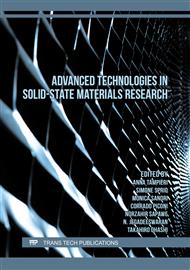[1]
J.-H. Zeng, S.W. Liu, L. Xiong, P. Qiu, L.-H-Ding, S-L Xiong, J.-T. Li, X.G. Lao, Z.-M- Tang, Scaffolds for the repair of bone defects in clinical studies: a systematic review, J. Orthopaedic Surgery and Res. 13 (2018) 33.
DOI: 10.1186/s13018-018-0724-2
Google Scholar
[2]
C.M. Simpson, G.M. Calori, P.V. Giannoudis, Diabetes and fracture healing: the skeletal effects of diabetic drugs, Expert Opin Drug Saf. 11 (2012) 215–220.
DOI: 10.1517/14740338.2012.639359
Google Scholar
[3]
P.V. Giannoudis, D. Hak, D. Sanders, E. Donohoe, T. Tosounidis, C. Bahney, Inflammation, Bone Healing, and Anti-Inflammatory Drugs: An Update, J. Orthop Trauma, 29, 12 Suppl., Dec (2015).
DOI: 10.1097/bot.0000000000000465
Google Scholar
[4]
M. Georgiana Albu, I. Titorencu, M. Violeta Ghica, Collagen-Based Drug Delivery Systems for Tissue Engineering. In: Biomaterials Applications for Nanomedicine. R. Pignatello, ed. London: IntechOpen; (2011).
DOI: 10.5772/22981
Google Scholar
[5]
A.R. Boccaccini, J.J. Blaker, Bioactive composite materials for tissue engineering scaffolds, Expert Rev Med Devices. 2, 3 (2005) 303-317.
DOI: 10.1586/17434440.2.3.303
Google Scholar
[6]
S. Sprio, M. Sandri, S. Panseri, C. Cunha,; A. Tampieri, Hybrid Scaffolds for Tissue Regeneration: Chemotaxis and Physical Confinement as Sources of Biomimesis, J. Nanomaterials, (2012), 418281.
DOI: 10.1155/2012/418281
Google Scholar
[7]
S.H. Lee, H. Shin, Matrices and scaffolds for delivery of bioactive molecules in bone and cartilage tissue engineering, Adv. Drug Deliv. Rev. 59 (2007), 339-359.
DOI: 10.1016/j.addr.2007.03.016
Google Scholar
[8]
I. Romero-Castillo, E. López-Ruiz, J.F. Fernández-Sánchez, J.A. Marchal, J. Gómez-Morales, Self-Assembled Type I Collagen-Apatite Fibers with Varying Mineralization Extent and Luminescent Terbium Promote Osteogenic Differentiation of Mesenchymal Stem Cells, Macromol. Biosci. 21 (2021) 2000319.
DOI: 10.1002/mabi.202000319
Google Scholar
[9]
J. Gómez-Morales, C. Verdugo-Escamilla, R. Fernández-Penas, C.M. Parra-Milla, C. Drouet, F. Maube-Bosc, F. Oltolina, M. Prat, J.F. Fernández-Sánchez, Luminescent biomimetic citrate-coated europium-doped carbonated apatite nanoparticles for use in bioimaging: Physico-chemistry and cytocompatibility, RSC Adv. 8 (2018) 2385–2397.
DOI: 10.1039/c7ra12536d
Google Scholar
[10]
X. Li, Q. Zou, H. Chen, W. Li, In vivo changes of nanoapatite crystals during bone reconstruction and the differences with native bone apatite. Sci. Adv. 2019, 5, 2375.
DOI: 10.1126/sciadv.aay6484
Google Scholar
[11]
J. Gómez-Morales; R. Fernández-Penas; F. J. Acebedo-Martínez; I. Romero-Castillo; C. Verdugo-Escamilla; D. Choquesillo-Lazarte; L. Degli-Esposti; Y. Jiménez-Martínez; J. F. Fernández-Sánchez; M. Iafisco; H. Boulaiz, Luminescent citrate-functionalized terbium-substituted carbonated apatite nanomaterials: structural aspects, sensitized luminescence, cytocompatibility, and cell uptake imaging, Nanomaterials 12,8 (2022) 1257.
DOI: 10.3390/nano12081257
Google Scholar
[12]
J. Gómez-Morales, R. Fernández-Penas, C. Verdugo-Escamilla, L. Degli-Esposti, F. Oltolina, M. Prat, M. Iafisco, J. F. Fernández Sánchez, Bioinspired mineralization of type I collagen fibrils with apatite in presence of citrate and europium ions, Crystals, 9,1 (2019) 13.
DOI: 10.3390/cryst9010013
Google Scholar
[13]
Oryan, A., Kamali, A., Moshiri, A., Baharvand, H., & Daemi, H. (2018). Chemical crosslinking of biopolymeric scaffolds: Current knowledge and future directions of crosslinked engineered bone scaffolds. International Journal of Biological Macromolecules 107, 678–688.
DOI: 10.1016/j.ijbiomac.2017.08.184
Google Scholar
[14]
Feng, W. Q., Wang, L. Y., Gao, J., Zhao, M. Y., Li, Y. T., Wu, Z. Y., & Yan, C. W. (2021). Solid state and solubility study of a potential anticancer drug-drug molecular salt of diclofenac and metformin. Journal of Molecular Structure, 1234, 130166.
DOI: 10.1016/j.molstruc.2021.130166
Google Scholar



